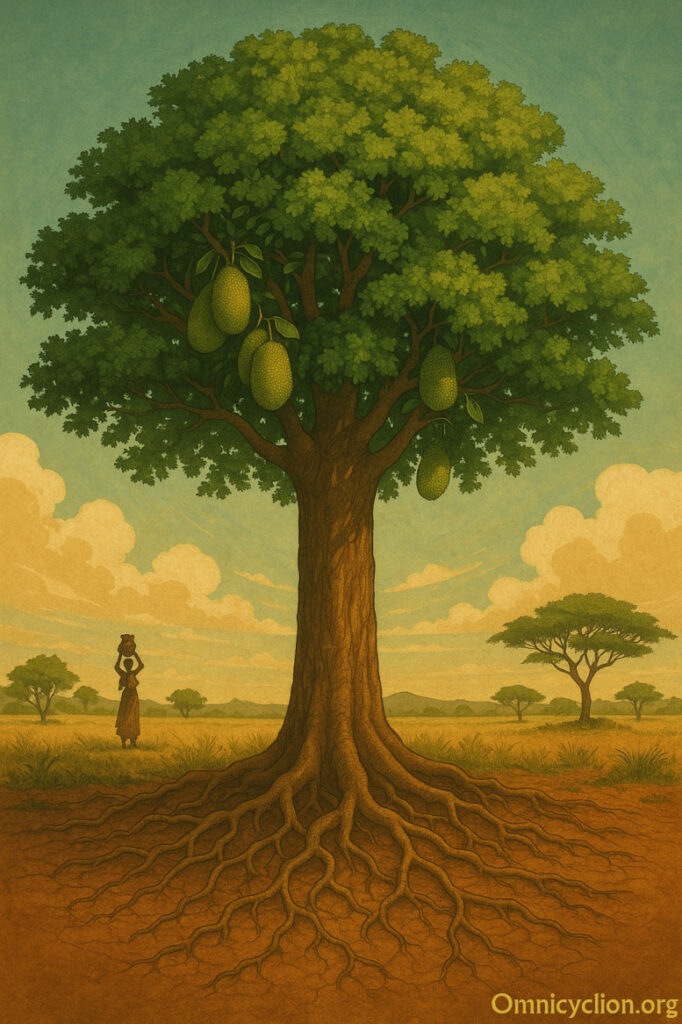Jackfruit Trees for Africa

In a century overshadowed by drought, climate disruption, and the loss of arable land, Africa stands at the crossroads between scarcity and abundance. The continent is rich in resilience, ingenuity, and community — yet millions of its people are threatened by food insecurity and soil degradation. The time has come to rediscover an ally both ancient and new: the jackfruit tree (Artocarpus heterophyllus).
A Giant Among Trees
The jackfruit tree, native to South and Southeast Asia, is the largest fruit-bearing tree in the world. Mature specimens can rise over 20–30 meters tall and live productively for half a century or more. Each tree can yield 100 to 200 fruits annually, with individual fruits weighing up to 50 kilograms. From one tree alone, several tons of food can be harvested year after year.
Propagating jackfruit from cuttings or grafts can be a practical way to establish trees, ensuring faster fruiting and uniform quality. However, it is important to remember that relying too heavily on cloned material can reduce genetic diversity, making orchards more vulnerable to pests, diseases, and climate stresses. For resilience, communities should balance grafted or cutting-grown trees with those raised from seed. The cutting method itself is simple: select healthy young branches, trim them to 20–30 cm lengths, dip the cut end in rooting hormone (or even wood ash as a natural alternative), and plant them in moist, well-drained soil under partial shade until roots develop. With care, such rooted cuttings can be transplanted into the field and grown into productive trees.
Where maize, sorghum, and cassava exhaust soils and demand replanting, the jackfruit tree simply continues to give. Its deep roots reach into aquifers as far as 30 meters down, tapping secure water reserves beyond the reach of seasonal drought. In African conditions of drying rains and desertification, this is not just an advantage — it is a revolution.
Climate-Proof Nutrition
Jackfruit is more than a miracle of quantity; it is a miracle of quality.
- Fruit flesh provides carbohydrates, Vitamin C, Vitamin A, antioxidants, and valuable dietary fiber.
- Seeds contain up to 18% protein, filling a gap in protein-scarce diets.
- Leaves can be used as fodder for livestock.
- Timber is termite-resistant and highly valued for construction and furniture.
Unlike many staple crops, jackfruit does not depend on imported fertilizers or pesticides. It flourishes in agro-forestry systems where multiple crops are grown together — the traditional way of farming practiced by humanity for millennia. In this sense, jackfruit reconnects Africa with its ancient ecological wisdom while pointing forward toward a sustainable future.
Restoring the Land, Calling the Rain
Jackfruit trees do more than feed people. By shading the soil, binding it with their deep roots, and building leaf litter that regenerates humus, they heal exhausted land. Forest cover itself influences the water cycle: trees attract moisture, draw down rain, and cool the local climate. To plant a jackfruit tree is therefore to restore the whole living system — soil, water, climate, and community.
Self-Empowerment Through Abundance
From a social perspective, jackfruit represents self-sufficiency. Instead of dependence on imported grains or aid shipments, villages can harvest what grows at their doorstep. Children raised with jackfruit as a daily staple know the taste of resilience.
This is empowerment in the truest sense: not charity handed down, but abundance grown within. In Omnicyclion’s view, this is spiritual as well as practical. Each jackfruit tree is a living altar of Ubuntu: I am because we are. Its towering trunk and overflowing fruits testify to unity, cooperation, and shared survival.
Recognized on the Global Stage
The vision is not ours alone. Major organizations are beginning to see the same truth. Trees for the Future (trees.org), working across Sub-Saharan Africa, has pioneered “Forest Garden” systems that integrate trees, vegetables, and staple crops into sustainable mosaics of food and income. Their work has been recognized by the United Nations as a Flagship Project for ecosystem restoration.
In the Forest Garden model, jackfruit takes its rightful place as a cornerstone species — anchoring diverse plantings, regenerating land, and feeding families for generations.
Toward the Best Possible Future
Africa’s future need not be written in the language of famine and dependence. With jackfruit, and with the wisdom of agro-forestry, Africa can write a new story: of reforested hills, fertile soils, abundant harvests, and communities resilient in the face of climate change.
Every jackfruit tree is more than a provider of food. It is a wellspring of hope, a green cathedral where Earth and Heaven meet, and a teacher that shows us: when we plant deeply, together, we will endure.